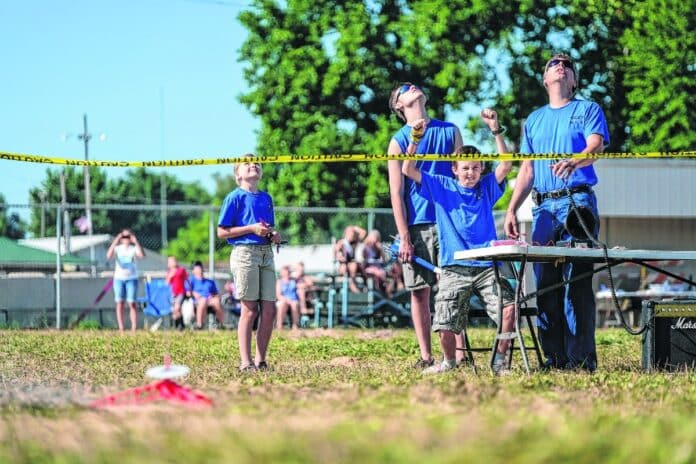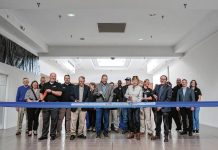
We have liftoff!
About a dozen children ages 10 to 16 who are participating in 4-H gathered in a field outside the grandstand at the Bartholomew County 4-H Fairgrounds to launch the model rockets they had constructed.
Most of the rockets launched successfully Friday, though a couple wouldn’t ignite when on the launch pad. One rocket’s parachute failed to deploy, resulting in the rocket making a hard landing on a nearby street.
“This is fun and exciting and interesting,” said Scott Decker, who, along with his wife, Laura, lead the Happy H-ers club, which typically participates in the Purdue Extension 4-H Aerospace Project. “Something that I like is that every once in a while something fails. I kind of like that because it’s good for (the children) to understand that the failure of an experiment, if you will, is OK. That’s a good thing. You learn something from that. That’s how we learn.”
[sc:text-divider text-divider-title=”Story continues below gallery” ]Click here to purchase photos from this gallery
Model rockets are small rockets made of cardboard tubes, paper, wood, plastic and other materials and can reach altitudes of 300 feet to 1,600 feet before a parachute or other device is deployed so the rocket gently glides back to the ground, according to the National Association of Rocketry.
The idea of the 4-H aerospace project is to show children that science and engineering can be fun and teach them about rocket propulsion, principles of flight, model rocket safety and life skills, Scott Decker said. The children assemble and paint the rockets themselves. The club has been launching rockets for the past five years.
The children start with cardboard tubes and then sand the rockets’ fins and glue them onto the tube, Laura Decker said. Once the glue dries, which often takes around 24 hours, the children install the engine mounts, put together the parachutes and paint them. Laura Decker said club members meet once per month starting in February to work on the rockets.
“There are requirements per grade level,” she said. “The older children have fancier fin designs or two-stage rockets. The younger ones had simpler rockets.”
The Deckers were inspired to launch model rockets with 4-H because of a summer internship Scott Decker had in the late-1980s with the National Aeronautics and Space Administration at the NASA Lewis Research Center in Ohio (now known as the NASA John H. Glenn Research Center at Lewis Field) while he was attending Geneva College, where he received bachelor degrees in electrical engineering and computer science.
“It inspired me when it came to engineering and sciences,” said Scott Decker, while helped set up for the launch with his son, Jaden, 15, who is part of the club. “Everyone kind of thinks of science being boring — math, you know? It’s hard. I’m not going to tell you it’s not. But this is fun.”
Before the launch, Scott Decker roped off a safety perimeter 15 feet around the launchpad so nobody would get hurt in case a rocket malfunctioned. One child at a time placed their rocket on the launchpad and then stepped outside the safety perimeter and sat at a launch control station. The rest of the children stood hundreds of feet away, waiting to see if they could go catch the rocket when it glided back to the ground.
At the station, the child whose rocket was on the launchpad counted down from five while speaking into a microphone hooked up to a Marshall guitar amplifier. Then, if all went well, the rocket would shoot up in the sky, nearly disappearing from view. The rest of the children would then attempt to run after the rocket and retrieve it before it hit the ground. One rocket was launched at a time.
Cole Brown, 16, said he was cautiously optimistic about launching his latest rocket, which he had painted blue and had put on decals to make it look like a shark.
“Most of my rockets, usually something bad happens to them,” Brown said. “My first one, I launched it off, and the engine mount shot out the back. And my second one, it got all ripped up and the parachute got all tangled. This one, well, the top is a little bit beaten up… and the bottom stage melted off. So I am hoping my newest one doesn’t explode or anything bad happens to it.”
Brown said his favorite part is building the rockets.
“I like building them,” he said.
Brown’s rocket did not explode. Instead, it shot off like a surface-to-air missile before the parachute popped out and returned safely to the ground.
Nathaniel Morris, 15, said it was his third year launching rockets with 4-H. He said worked on and off on his rocket for two to three months and was excited to see how his rocket would do.
“I just really enjoy watching them fly into the sky and come back down fast,” Morris said.
Before the launch, Wyatt Brown, 13, was busy separating engine igniters before installing them on three rockets he had built and painted. The igniters come in pairs, but only one is needed to launch the rocket, he said.
“This thing takes the spark and the spark lights the engine, which makes it shoot off,” said Wyatt Brown, holding up an igniter.
Wyatt Brown said he just likes “launching and catching them.”
[sc:pullout-title pullout-title=”For more information” ][sc:pullout-text-begin]
Contact the Bartholomew County Purdue Extension at 812-379-1665 to get involved in with rockets in 4-H.
Visit 4honline.com for more information about 4-H or to register.
[sc:pullout-text-end]




